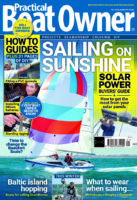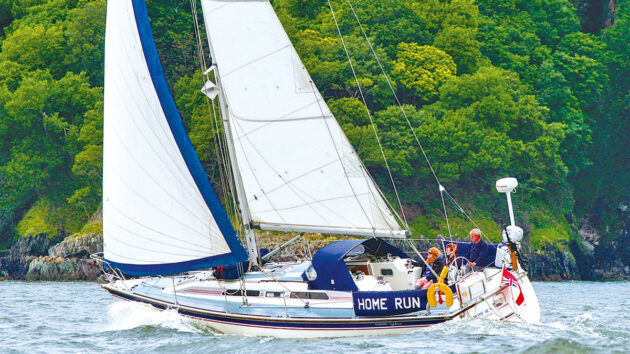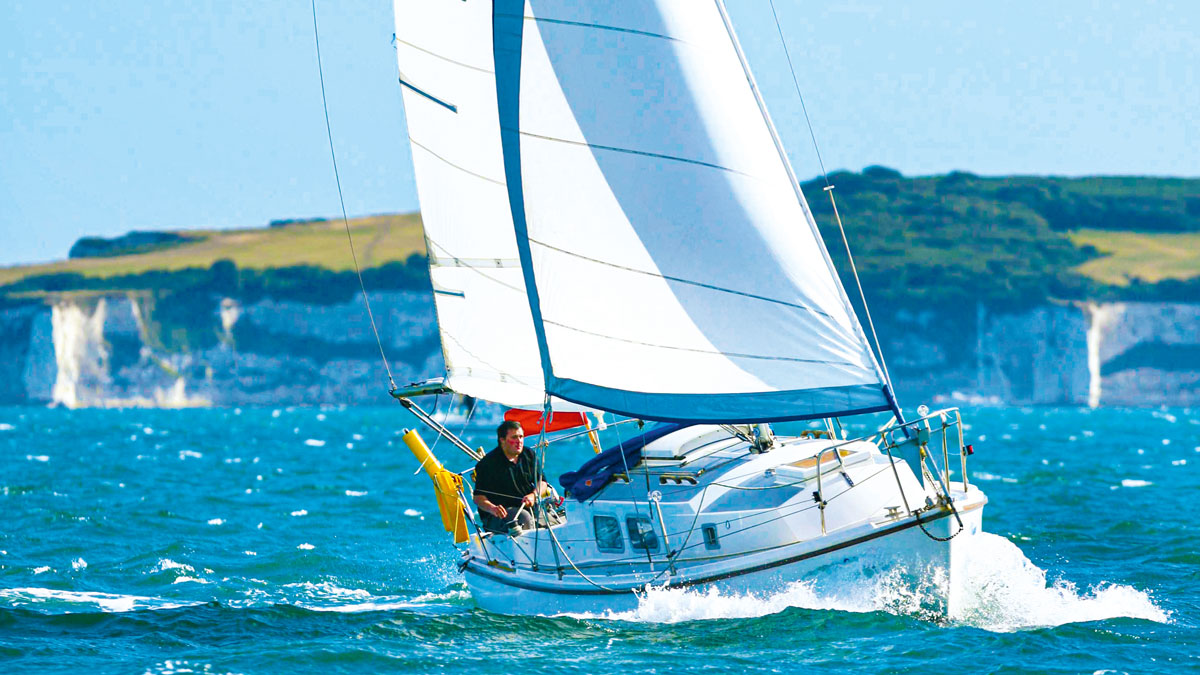Rupert Holmes looks at the the Westerly Typhoon 37, his favourite Westerly model of all time, and other alternative boats you might want to consider
Westerly had a reputation for building sturdy, though unexciting, cruising boats that offered a lot of space and comfort by the standards of their era. The company also produced some less well-known, more performance-orientated boats that can be an excellent choice for many owners, such as the Westerly Typhoon 37.
Among the 60-plus models produced by Westerly in its long and chequered history, the 32ft Fulmar is often cited as the best boat the yard ever built. In many ways, this Ed Dubois design broke ranks with earlier mainstream Westerly models, offering a more performance-orientated boat with a powerful fractional rig, yet it was easily handled and offered decent accommodation.
The Fulmar also quickly gained a deserved reputation as being an excellent sea boat, as well as one that is tough enough to withstand the inevitable knocks and bumps that a hard-worked boat will gradually collect. Both these points were amply demonstrated when the Westerly Sea School opened in 1987, with a fleet of a dozen Fulmars that operated all year and in almost any conditions, including winter gales.
The Storm 33 and Tempest 31 are also excellent designs that are more performance-orientated than most Westerlys, but there is one later and lesser-known model that embodies everything that was good about the Fulmar, adds a higher standard of finish and larger interior, plus a more efficient, low centre-of-gravity bulb keel: the Westerly Typhoon 37.
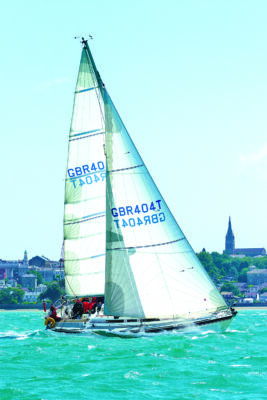
About 40 Westerly Typhoon 37s were built, and they hold their prices well. Photo: David Harding.
The Westerly Typhoon 37
Another Dubois design, this 37-footer was launched in 1990, a decade after the Fulmar and remained in production in various guises until the demise of the firm a decade later.
The Westerly Typhoon 37 was conceived as a bigger and better Fulmar, with good performance that includes excellent ability upwind, manageable handling and very civilised accommodation in either two- or three-cabin layouts. It also spawned two later models, the Regatta 370 and Ocean 37.
I tested the prototype of the last version produced, the Ocean 37, which was hugely rewarding to sail over a wide range of conditions. We were able to sail rings around a Bavaria 37 that was on test at the same time, while well-thought-out quality deck gear facilitated accurate sail trim that both improves the motion at sea and reduces passage times.
Westerly Typhoon 37 specifications:
LOA: 11.40m/37ft 4in
LWL: 9.80m/31ft 11in
Beam: 3.80m/12ft 4in
Draught: 1.83m/6ft 0in
Displacement: 7,470kg/16,470lb
Ballast: 2,750kg/6,050lb
Mainsail: 33.6m2/361ft2
Foretriangle area: 29.4m2/316.5ft2
Owners’ association: westerly-owners.co.uk
Westerly Typhoon 37 reaching ability
Upwind ability is often not thought to be important in a cruising yacht.
However, if you have a boat that will tack through 80°, once you’ve borne away to a true wind angle around 55°, you’re already cracked off on a reach with sheets eased. It’s a different world from a boat that’s still in full upwind mode at the same wind angle, and also means that, when an uncomfortable windward passage can’t be avoided, it’s over more quickly. The boat proved well behaved when reaching and was willing to surf readily, but under easy control, on a quartering sea.
Generous sail area helps promote light airs speed, yet the big mainsail is easily tamed. For a start, the fractional rig enables the backstay to be used to flatten the mainsail as the wind increases. The set-up also allows quick and easy reefing from the cockpit – when I tested the Ocean 37, we timed how long it took one person to tuck in the first reef: 50 seconds.
Unsurprisingly, interior volumes are lower than those of the 36ft Westerly Corsair, which has greater freeboard and a centre cockpit, creating plenty of headroom in the aft cabin.
Still, the Westerly Typhoon 37’s galley and navigation station won praise as being among the best of any boat in the range. The saloon was also open and airy by the standards of the time, though the woodwork is darker than that of most of today’s yachts, and there’s a lot less natural light.
Early examples had a two-cabin layout, with one double cabin aft. This is significantly larger than most typical quarter cabins, with a lot more floor space and a small settee. Later boats also had the option of a smaller double quarter cabin on one side, plus a separate single cabin opposite.

Testing the Westerly Typhoon 37 Talisker 1 off the Suffolk coast. Typhoons have decent deck gear, facilitating easy sail trimming and reefing. Photo: James Tomlinson.
Two possibilities were offered for the forepeak area – either a pair of single bunks at different heights, giving plenty of foot space for each bunk, or a conventional double vee-berth. In reality, it’s not a particularly expensive job to swap between the two arrangements, so this shouldn’t dictate the choice of boat. Both options also had an en suite heads and basin forward, as well as an aft heads.
Despite the boat’s more performance bias, construction was largely similar to that of most Westerlys, consisting largely of hand-laid chopped strand mat, but with two layers of osmosis-resistant isophthalic gel coat and isophthalic resin used for the first layer of mat.
Biaxial cloth in combination with unidirectional fibres was also used strategically for additional reinforcement. The deck moulding uses a foam core, which is less likely than balsa cores to develop problems in the event of moisture ingress.
Earlier Typhoons were fitted with a 28hp Volvo Penta 2003 diesel engine, while later versions and Regatta 370s had the Perkins-based Volvo Penta 2030, which is widely regarded as being a more robust unit.
Around 40 Westerly Typhoon 37s were built before the model was revamped as the Regatta 370 in late 1993. This had a radical interior styled by Ken Freivokh aimed at combating competition from French designs in particular. However, it didn’t prove popular and only eight boats were sold, though the 1990s recession made this a tough time for all UK boatbuilders.
The design also had a later makeover to become the Ocean 37 in 1999, with a more conventional high-quality interior. But by then, a consistent lack of investment meant Westerly had become a low-volume builder with associated high unit costs.
When I visited the Waterlooville factory around this time, interior woodwork was being carried out by teams of skilled craftsmen working with electric jigsaws and hand tools within each hull. By contrast, Bavaria had state-of-the-art CNC tooling that cut each piece of timber to the precise shape and size needed and even sprayed it with lacquer.
As a result, even though the Ocean 37 was a significantly better boat than the vast majority of the competition, it was hopelessly expensive to produce, and only two examples were built before Westerly folded for the final time. Nevertheless, 25 years later, the 50 boats built on this hull remain desirable and have held their value better than others of a similar size and era.
Comparing the Sadler Starlight 35 and the Westerly Typhoon 37
This Stephen Jones design from 1991 is a slightly smaller option than the Westerly Typhoon 37, but was seen as being one of the most desirable cruising yachts of its era and sold well despite a rather high price point.
Today, it retains a reputation as a solid, well-mannered and rewarding boat to sail that benefits from clever design thinking and a high standard of fit-out.

Sail control lines are led back to the cockpit, ideal for short-handed sailing. Photo: David Harding.
As a result, Starlights tend to hold their value better than other designs of a similar size and age, although in part this reflects knowledgeable and enthusiastic owners who keep their boats in good shape, with regularly updated systems and equipment.
Although the hull volume is much greater than that of earlier designs, including the Sadler 34 from 1983, the Starlight was designed to be comfortable at sea, with an easy motion.
At the same time, low centre of gravity keels, even in shoal draught versions, confer significantly more stability than earlier designs. This represents an important step forward compared to older boats, though the big wings on the shallow keel increase drag that saps speed in light airs.
The boat also benefits from a well-thought-out deck layout that didn’t skimp on hardware, making sail trimming a joy.
By the time the Starlight 35 was launched, French designs of this size had already been offered in three-cabin versions for a decade, yet no attempt was made to squeeze two quarter cabins into the back of the Starlight 35. As a result, there was no pressure to widen the stern sections to an extent that would adversely affect handling and create extreme weather helm when the boat is well heeled.
Instead, it benefits from a spacious cabin on one side, plus a well-executed heads compartment on the other, and a large cockpit locker. There’s also a second spacious cabin in the forepeak.
The larger Starlight 39, however, was offered with the option of a three-cabin layout with two heads compartments. Originally, the 39 was a considerably more expensive option, but prices of second-hand boats have converged over the years, so it could be a good option for anyone needing a three-cabin layout.
Both models survived Sadler’s demise in 1993, when production transferred from Poole to Rival Bowman’s facilities in Southampton. Most sources state production continued until 1997, though I sailed a new boat billed as a Mark 2 version in late 1998, so I checked with Adrian Jones, co-owner of Rustler Yachts in Falmouth.
He confirmed they bought the Starlight and Bowman brands when Rival Bowman went under in 2000 and that several Starlight 35s were then built in Cornwall, with the last Sadler 35 being number 108, which was launched in 2007.
Sadler Starlight 35 specifications:
LOA: 11.00m/36ft 1in
LWL: 8.56m/28ft 0in
Beam: 3.50m/11ft 6in
Draught (deep keel): 1.80m/5ft 9in
Draught (shoal keel): 1.50m/4ft 11in
Displacement: 6,143kg/13,514lb
Ballast: 2,556kg/5,623lb
Sail area: 53.33m²/574ft²
Moody S38
In the 1990s, Westerly was by no means alone among British boatbuilders in successfully creating a more performance-aimed range of cruising boats than their mainstay designs. In 1995, for instance, Moody commissioned Bill Dixon to create more performance-oriented 31- and 38-footers. Both are markedly faster and have a more modern style than the centre cockpit cruisers for which the firm is better known.
The S38 is an aft cockpit model with a choice of lofty fractional or standard masthead rigs. The fractional version is a twin spreader option with an extra 7m2 (75ft2) of sail area compared to the standard boat. Even so, this is not a high-power lightweight boat – both the displacement/length ratio of 240 and sail area/displacement ratio of 15.4 are firmly in the range for a moderate cruiser.
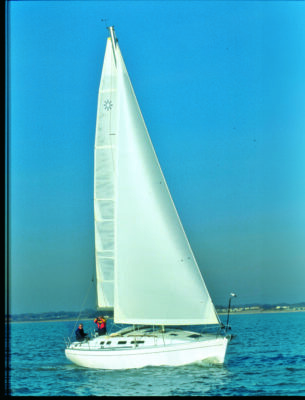
Moody S38 Test Solent December 1995. A slab-reefing mainsail with two full-length and two conventional batons and furling genoa was standard on the S38.
While the interior may lack some of the feeling of volume and privacy offered by the centre cockpit designs that have the sleeping cabins at opposite ends of the boat, it still offers bright and spacious accommodation in either two- or three-cabin layouts, both of which have two heads compartments. The wide beam translates into plenty of volume for the saloon, while the U-shaped galley is particularly spacious, and there’s also space for a decent chart table.
On two-cabin versions, the aft cabin stretches across the full width of the boat, offering a lot more volume than might be expected, along with good floor space and reasonable stowage. On three-cabin boats, this area is used for a pair of mirror-image double quarter cabins. Both layouts share the same large en suite forecabin, which benefits from plenty of stowage and generous floor space.
Today, the Moody S38 still makes a good choice as a well-mannered cruising yacht, even if there are faster alternatives. However, it proved much less popular than Moody’s older centre cockpit designs of a similar size, with only 60 boats built over its three-year production run.
Moody S38 specifications:
LOA: 11.89m/39ft 0in
LWL: 9.91m/32ft 6in
Beam: 3.95m/12ft 11in
Draught (shoal keel): 1.5m/4ft 11in
Draught (deep keel): 1.91m/6ft 3in
Displacement: 8,650kg/19,064lb
Mainsail: 32.2m2/346ft2
Furling genoa: 42.0m2/452ft2
Owners’ association: moodyowners.org
Jeanneau Sun Odyssey 37 and Sun Fast 37
These popular and spacious designs from 1998 combine good performance and handling with impressive accommodation, and are representative of excellent new and keenly priced models from across the Channel with which Westerly was attempting to compete almost a decade after the Westerly Typhoon 37 was first launched.
In the Jeanneau Sun Odyssey and Sun Fast 37, a generous beam gives more internal volume than earlier designs, even though the maximum beam is not carried as far aft as on later boats. Two and three-cabin layouts were offered, both with spacious saloons and well-appointed galleys, plus a forward-facing chart table with a dedicated seat.
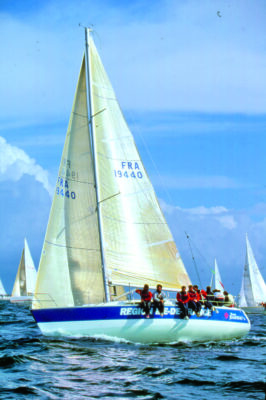
A Jeanneau Sun Fast 37 in full-on race trim. Photo: Jeanneau.
A large forecabin has plenty of stowage and good standing room at the head of the double berth, while a key feature of the two-cabin version is a heads compartment that incorporates a separate shower stall. Today, this is not an uncommon feature, but it was still a novelty on boats of this size 25 years ago – indeed, this was the first sub-40ft boat I tested with this arrangement.
Designer Jacques Faroux tucked the big spade rudder well under the hull, where it’s clear of turbulent water near the transom. This means that, unlike some single rudder wide stern boats, it retains good control even at high angles of heel and when surfing downwind in stronger breezes. Equally, the combination of high form stability for its era with a deep bulbed keel, confers a high degree of sail carrying ability, reducing the need to reef frequently in gusty conditions.
The Sun Fast version has a slightly deeper keel, with a draught of 2.07m (6ft 10in) allied to a rig almost four feet taller. The additional sail area transforms performance in light airs, while the more efficient keel helps to speed progress to windward.
Improved deck hardware also made it easier to control sail shape and to depower in gusts.
Both versions have a spacious cockpit, including a central table, plus wide side decks. There’s also easy access to the water thanks to a central gate in the transom and a decent-sized bathing platform – it’s a better arrangement in this respect than the closed transom on the Westerly Typhoon 37.
Jeanneau Sun Odyssey 37 and Sun Fast 37 specifications:
LOA: 11.40m/37ft 4in
Hull length: 11.00m/36ft 1in
Beam: 3.70m/12ft 1in
Draught (standard keel): 1.95m/6ft 5in
Displacement: 6,100kg/13,450lb
Ballast: 1,840kg/4,060lb
Mainsail: 29.3m2/315ft2
Furling genoa: 38.5m2/415ft2
Builder: www.jeanneau.com
Sigma 38
This is a slightly older model, a David Thomas design dating from the mid-1980s, yet today it ticks a lot of boxes as a fast and well-mannered performance cruiser that also offers three-cabin accommodation.
When new, these were seen as very racy boats and 70-strong one-design fleets used to compete in Cowes Week – an impressive number given only 125 boats were sold in total. I’ve known Sigma 38s to achieve speeds in the mid-teens on surfs while being pushed hard in strong winds in offshore races such as the Rolex Fastnet. Indeed, family crewed Sigma 38s took second and fifth place in the windy 2007 edition in a class that had only eight finishers out of an initial entry of 60 boats.
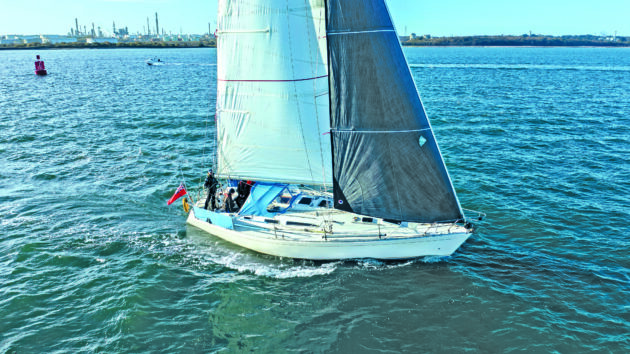
The deep fin keel and spade rudder make the Sigma 38 highly manoeuvrable. Photo: Richard Langdon.
Nevertheless, with a few tweaks, it’s easy to transform the sail handling to enable the boat to be reefed from the cockpit for easy cruising and, by today’s standards, this is a moderate design with ample displacement.
The large rig helps boost light weather performance, yet the Sigma 38 also has a long-standing reputation for being able to take heavy weather well. There’s no bulb on the bottom of the keel, but a deeper draught means there’s enough ballast carried low down for good stability, though the big mainsail needs reefing earlier than those of boats with less power.
There are few options for three-cabin boats in this price range, even if the aft cabins are a little narrower than most, while only a single heads compartment was offered. But there’s also a decent galley and proper chart table with its own forward-facing seat.
The saloon feels more cramped than that of many, as a result of the pilot berths positioned outboard of the settees. On the plus side, these are excellent for stowage when cruising, a factor that’s all too frequently missing on more recent designs, even if they initially appear to have a greater feeling of space.
Today, almost all examples are now equipped for cruising, with many having had significant upgrades to deck gear and the sail plan to achieve this.
These boats in particular represent capable vessels that are rewarding to sail and equally suitable for fun family cruising, inshore or offshore racing, and long-distance voyaging.
In the 1990s, I did numerous cross-Channel cruises on a Sigma 38, and it was always a boat I looked forward to sailing, finding it to be quick, well-mannered and rewarding to sail.
Sigma 38 specifications:
LOA: 11.58m/38ft 0in
LWL: 9.45m/31ft 0in
Beam: 3.71m/12ft 2in
Draught: 2.05m/6ft 8in
Displacement: 6,237kg/13,750lb
Ballast: 2,613kg 5,760lb
Sail area: 64.20m2/691ft2
Class association: www.sigma38.co.uk
Beneteau First 36.7
This is a later model from Farr Yacht Design with more emphasis on performance. A number were pushed hard as offshore race boats when newer, proving capable even in tough editions of the Rolex Fastnet Race.
Today, Beneteau Firsts are regarded as a moderate design that nonetheless combines speed with good handling characteristics, especially when fitted with a roller furling headsail and mainsail reefing that can be operated from the cockpit.
Two keel options were offered, with the standard boat having a deep 2.2m (7ft 3in) keel with an L-shaped bulb, while the shallow version draws 1.8m (5ft 11in).
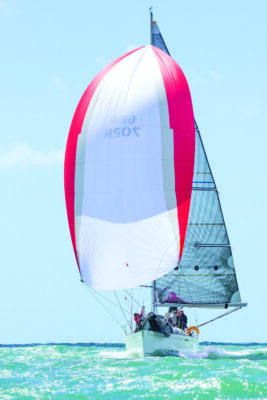
The Beneteau First 36.7 was offered with two keel options, deep and shallow. Photo: David Harding.
Unusually, Beneteau only offered this model with three-cabin accommodation. It’s a smaller boat overall, however, than the Westerly Typhoon 37, with markedly less stowage, a much smaller galley and only one heads compartment.
In total, some 800 boats are reported to have been built between 2002 and 2008, including some in Beneteau’s former Annapolis factory.
First 36.7s are therefore relatively easy to find on the second-hand market and can make an excellent option for someone seeking a faster boat that’s fun to sail and benefits from higher specification deck hardware than most boats designed with only cruising in mind.
Beneteau First 36.7 specifications:
LOA: 10.90m/35ft 9in
Hull length: 10.68m/35ft 0in
Beam: 3.45m/11ft 4in
Draught: 2.20m/7ft 3in or 1.8m/5ft 11in
Displacement: 5,870kg/12,950lb
Ballast (deep keel): 1,745kg/3,850lb
Mainsail: 38m2/410ft2
No1 Genoa: 40.5m2/435ft2
Builder: beneteau.com
Hanse 371
The second generation of Hanse models were entirely new Judel/Vrolijk designs and launched in what were still early days for this German yard that has subsequently gone on to build more than 14,000 boats.
The 371 was the third smallest boat in a line of six boats from 31ft to 53ft, and was produced from 1999 to 2006.
Founder Michael Schmidt started the yard with a key set of principles in mind, particularly that all Hanses would be easy to handle, and this remains one of the brand’s core values. They are therefore fitted with self-tacking headsails and single-line reefing that can be operated from the cockpit.

The standard self-tacking headsail on the Hanse 371 provides ample power for cruising in a Force 4 and above.
On the downside, the small headsail limits speeds in light airs, particularly when reaching or off the wind. However, today this is easily remedied by the addition of a furling Code 0.
The 371 has an efficient, well-mannered hull shape and offered a choice of deep or shallow, low centre of gravity fin keels allied to a hull with a long waterline for its era. A small number of boats also have a centreboard that swings up into a stub keel.
Below decks, there’s a choice of spacious two- or three-cabin layouts, both with a commendably large galley and a distinctive high gloss finish to the interior joinery. A deck saloon version was also offered, though few of these were sold.
The same hull, but a different deck moulding, was subsequently used for the Hanse 370 that continued in production for a further five years.
Hanse 371 specifications:
LOA:11.25m/36ft 11in
LWL: 9.80m/32ft 3in
Beam: 3.60m/11ft 10in
Displacement: 6,900kg/15,200lb
Ballast: 2,250kg/4,960lb
Builder: hanseyachtsag.com
Contessa 32: the second-hand classic + 6 alternative boats
Rupert Holmes analyses this extremely seaworthy classic and suggests a dozen other viable lower-cost alternatives
Best boats for a family: sail and power
Duncan Kent chooses a selection of sail and power boats that are ideally suited to cruising with your children and…
Best boat for crossing the Atlantic
What is the best boat for crossing the Atlantic? Ali Wood asks the owners of two catamarans and two monohulls…
Westerly Centaur: Britain’s most popular yacht
Rupert Holmes analyses the pros and cons for today’s boat owners of the most popular cruising yacht ever built in…
Enjoyed reading this article about the Westerly Typhoon 37?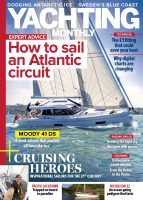
A subscription to Yachting Monthly magazine costs around 40% less than the cover price, so you can save money compared to buying single issues.
Print and digital editions are available through Magazines Direct – where you can also find the latest deals.
YM is packed with information to help you get the most from your time on the water.
-
-
- Take your seamanship to the next level with tips, advice and skills from our experts
- Impartial in-depth reviews of the latest yachts and equipment
- Cruising guides to help you reach those dream destinations
-
Follow us on Facebook, Twitter and Instagram.
Note: We may earn a commission when you buy through links on our site, at no extra cost to you. This doesn’t affect our editorial independence.

